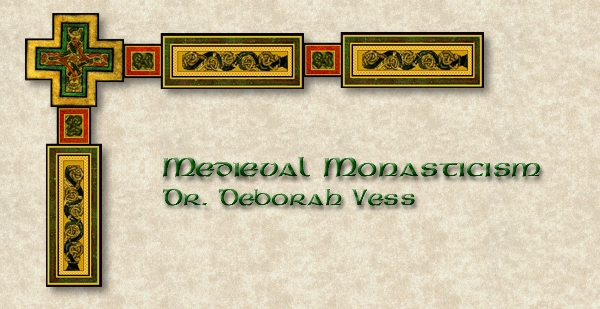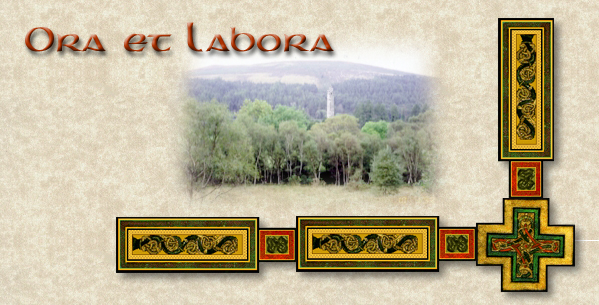
Cluny and Other Movements of the Central Middles Ages
Cluny
Charters of Cluny from The Cluny Project
The Cluny Project has extensive resources, including texts about Cluny and people associated with the monastery, images, and reconstructions of its possible appearance. You won't believe the links to reconstructions, including quicktime videos. Go there!
The Reform of Church Law: The Canonists
Medieval Sourcebook: Medieval Legal History
The Life of Burchard Bishop of Worms.
Scholasticism
The School of Chartres:
Richer of Rheims: Journey to Chartres
Anselm:
Proof of the Existence of God.
See also Catholic Encyclopedia: Anselm.
Anselm (1033-1109): Proslogium
Gaunilo: In Behalf of the Fool, with Anselm's: Reply
MonologiumSidney Dean's Introduction to Anselm's Writing
Philosophers' Criticisms of Anselm's Ontological Argument for the Being of God
Catholic Encyclopedia: Nominalism, Realism, Conceptualism
Abelard
Historia calamitatum excerpts in English
History of My Calamities full text in English (Henry Adams Bellows translation)
Latin Text of the Historia Calamitatum
Catholic Encyclopedia: Peter Abelard
Chronicles of Love and Resentment - Abelard and Heloise by Eric Gans.
Biography of Abelard from the Maritain Center; another Biography with a hymn and a prayer of Abelard's; the Ecole Glossary Biography
Peripateticus Palatinus: Story of Abelard from the ORB in three parts.
Fulk, Prior of Deuil, Letter to Peter Abelard
Heloise's Letter to Abelard in English translation, and in Latin and French translations.
Abelard and Heloise in the Art of Jean Vignaud.
Rage of the Heart Web Site: Musical about Abelard and Heloise
The Pen(is), Castration, and Identity: Abelard's Negotiations of Gender by Martine Irvine, Georgetown
Alexander Pope's Eloisa to Abelard
Although one can argue that scholasticism originated in monastic culture, as seen in the career of Anselm of Bec and Canterbury, the movement quickly shifted to the cathedral schools and later to the universities. The career of Abelard as master of the schools of Paris already foreshadowed this transition. For the later scholastics, especially Aquinas, see the Dominican page; see also the Franciscan page.
The Twelfth-Century Renaissance
Guibert of Nogent (1053-1124): Autobiography, and On His Childhood, excerpts from the Autobiography.
Adelard of Bath: Natural Questions, on the impact of Muslim science in the West.
Theophilus: An Essay Upon Diverse Arts
Alain of Lille (d.1203): The Plaint of Nature, full text.
Anglo-Norman Monasticism
Chronicle of the Abbey of St. Edmunds; see especially the Abbey of St. Edumunds and the Jews, and Gerald of Wales's account of the Discovery of the Tomb of King Arthur from his De Instructione Principis.
Manors of the Abbey of St. Peter, Winchester, from the Domesday Book
Charter of St. Patrick used by Glastonbury to elevate its status; see also the earlier grant of exemption from taxation to Glastonbury by King Edgar
Dr. V's Virtual Tour of Battle Abbey and the Battle of Hastings
Dr. V's discussion of Canterbury Cathedral Monastery and virtual tour of the Cathedral
New Orders of the Central Middle Ages
Orders founded on the Rule of St. Benedict:
The Camoldolese Benedictines eremitical interpretation of the RB.
Catholic Encyclopedia article on the Camaldolese and their founder, St. Romuald
The Sylvestrines and their founder St. Sylvester, founded 1213, followed the Rule of St. Benedict but were not of the Benedictine congregations.
The Olivetans (late Middle Ages -- founded 1319) a branch of the white monks (Cistercians)
Fontevrault:
Fontevrault was a double monastery founded around 1100 by Robert of Arbrissel and which followed the Rule of St. Benedict.
Order and Abbey of Fontevrault
Abbey Church, Order of Fontevrault
Fontevrault Abbey from Great Buildings Online
Fontevrault in Literature: excerpt from Les Miserables
Other Orders:
The Carthusians contains the statutues of the Carthusian Order; hermit order.
International Site of the Order of Canons Regular Of PrémontréThe Canons Regular of Prémontré in Arundel and Brighton
St. Norbert Abbey, founded in the 19th century
Catholic Encyclopedia article on canons and canonesses regular
The Gilbertines, founded as communities of nuns on the model of the Cistercian order, who refused to accept them, with attached communities of canons regular (The Rule of Augustine), and lay brothers and sisters.
Photo by Dr. Vess.
